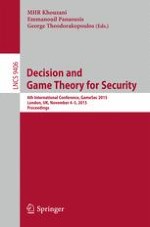2015 | OriginalPaper | Buchkapitel
Flip the Cloud: Cyber-Physical Signaling Games in the Presence of Advanced Persistent Threats
verfasst von : Jeffrey Pawlick, Sadegh Farhang, Quanyan Zhu
Erschienen in: Decision and Game Theory for Security
Aktivieren Sie unsere intelligente Suche, um passende Fachinhalte oder Patente zu finden.
Wählen Sie Textabschnitte aus um mit Künstlicher Intelligenz passenden Patente zu finden. powered by
Markieren Sie Textabschnitte, um KI-gestützt weitere passende Inhalte zu finden. powered by
Abstract
FlipIt game to model the struggle between the defender and attacker for control of the cloud. Because attacks upon the cloud can occur without knowledge of the defender, we assume that strategies in both games are picked according to prior commitment. This framework requires a new equilibrium concept, which we call Gestalt Equilibrium, a fixed-point that expresses the interdependence of the signaling and FlipIt games. We present the solution to this fixed-point problem under certain parameter cases, and illustrate an example application of cloud control of an unmanned vehicle. Our results contribute to the growing understanding of cloud-controlled systems.